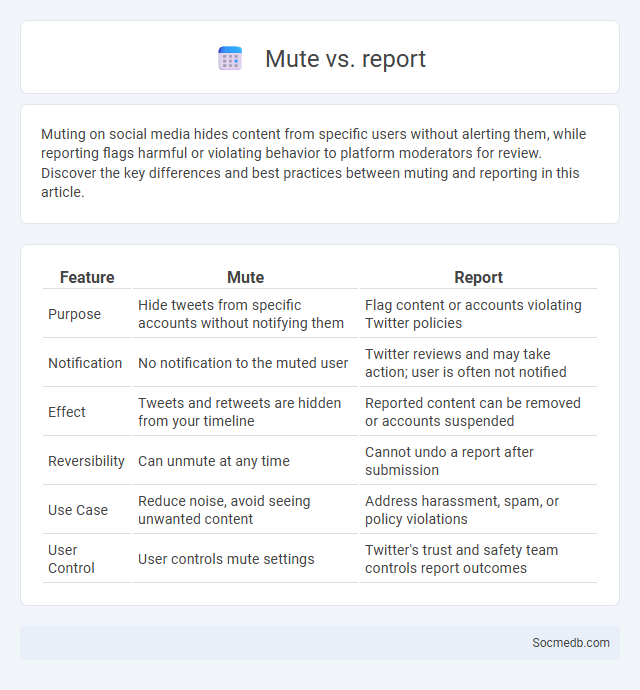
Photo illustration: mute vs report
Muting on social media hides content from specific users without alerting them, while reporting flags harmful or violating behavior to platform moderators for review. Discover the key differences and best practices between muting and reporting in this article.
Table of Comparison
| Feature | Mute | Report |
|---|---|---|
| Purpose | Hide tweets from specific accounts without notifying them | Flag content or accounts violating Twitter policies |
| Notification | No notification to the muted user | Twitter reviews and may take action; user is often not notified |
| Effect | Tweets and retweets are hidden from your timeline | Reported content can be removed or accounts suspended |
| Reversibility | Can unmute at any time | Cannot undo a report after submission |
| Use Case | Reduce noise, avoid seeing unwanted content | Address harassment, spam, or policy violations |
| User Control | User controls mute settings | Twitter's trust and safety team controls report outcomes |
Understanding the Differences: Mute vs Report vs Block
Understanding the differences between mute, report, and block on social media is crucial for managing your online experience effectively. Muting allows you to hide posts from specific users without unfollowing or notifying them, while reporting flags inappropriate content to platform moderators for review. Blocking completely restricts another user from interacting with you, preventing them from seeing your profile or contacting you directly.
What Does “Mute” Mean on Social Platforms?
"Mute" on social media platforms allows users to hide posts or updates from specific accounts without unfollowing or blocking them, maintaining a connection without seeing their content. This feature enhances user control over their feed by selectively filtering content that may be irrelevant or overwhelming. Popular platforms like Twitter, Instagram, and Facebook use mute functions to improve user experience and reduce unwanted notifications.
The Function and Impact of “Report”
The "Report" function on social media platforms empowers users to flag content that violates community guidelines, such as hate speech, harassment, or misinformation. By enabling Your active participation in content moderation, this tool helps maintain safe and respectful online environments while ensuring platform accountability. Effective use of the "Report" feature contributes to the reduction of harmful content, promoting healthier digital interactions and safeguarding user well-being.
When Should You Use “Block”?
Use "Block" on social media when interactions become consistently harmful, such as harassment, threats, or persistent spam that disrupt your online experience. Blocking prevents the offending user from viewing your content, commenting, or contacting you, ensuring a safer digital environment. It is an effective tool for maintaining privacy and control over your social media presence.
Scenarios: Mute, Report, or Block?
When navigating social media interactions, you have options such as muting, reporting, or blocking to manage your experience. Muting allows you to filter content without alerting the other user, preserving your timeline from unwanted posts discreetly. Reporting addresses violations of community guidelines by flagging inappropriate behavior, while blocking completely restricts another user's access to your profile and content, enhancing your personal online safety.
Privacy and Safety: Choosing the Right Option
Protecting your privacy on social media requires careful selection of platform settings and understanding data sharing policies. Use features like two-factor authentication, privacy controls, and content filters to enhance your account security and limit exposure to unwanted interactions. Ensuring your social media experience aligns with your safety preferences helps maintain control over your personal information and online presence.
Consequences for Users: What Happens Next?
Social media influences your mental health, often leading to increased anxiety, depression, and lowered self-esteem due to constant comparison and exposure to harmful content. Over time, excessive use can result in decreased productivity and disrupted sleep patterns, affecting overall well-being. Understanding these consequences helps you make informed choices to balance engagement and personal health.
Mute vs Report vs Block: Platform Policies Compared
Social media platforms enforce distinct policies for Mute, Report, and Block features to enhance user experience and safety. Mute allows users to hide content from specific accounts without alerting them, maintaining passive control over their feed. Report flags harmful or inappropriate content for platform review, while Block prevents all interactions and visibility between users to ensure personal boundaries and security.
Best Practices for Online Interactions
Maintaining respectful communication and active listening enhances online social media interactions, fostering positive community engagement. Utilizing clear, concise language and avoiding ambiguous statements prevents misunderstandings and digital conflicts. Prioritizing privacy settings and verifying information before sharing upholds security and credibility in online social networks.
Conclusion: Making the Right Choice for Digital Well-being
Prioritizing Your digital well-being requires choosing social media platforms that foster positive interactions and minimize negative impacts such as stress and misinformation. Evaluate the features and community standards of each platform to ensure they align with Your mental health goals and promote meaningful connections. Making informed decisions about Your social media use supports a balanced, healthier online experience.
 socmedb.com
socmedb.com